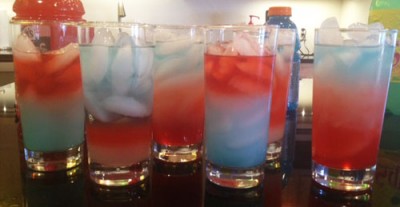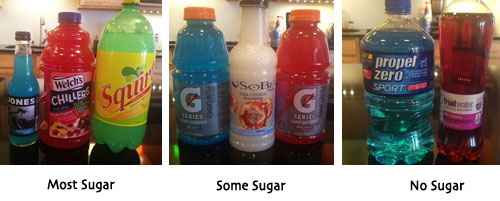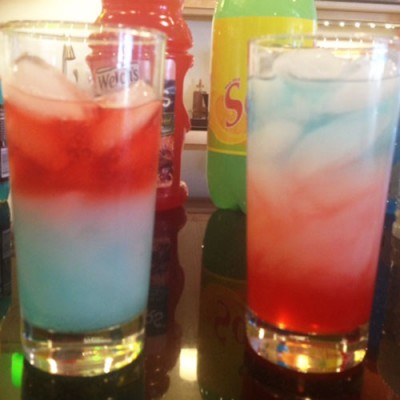Patriotic Layered Density Drinks for 4th of July
By Blog Editor Susan Wells
As you know, all of us at The Spangler Labs enjoy a good liquid density column. Our 9-Layer Density Tower is shared across the internet. It is one of our most popular Pinterest experiment pins. We are always looking for new combinations of liquids to stack (we have a lot of free time).
One popular density column found around the internet is a summer drink recipe perfect for the 4th of July. There are many alcoholic versions of the density drink, but we are going to focus on kid-friendly recipes.

This red, white and blue drink recipe uses a little science to delicately stack different drinks on top of each other. Your guests will think it’s magic, you will know it’s really science at work.
The different colored drinks are stacked by sugar density. The heaviest, or most sugary drink goes on the bottom, followed by the next sugary and ending with the least sugary. When choosing red, white and blue drinks, look at the sugar content per serving. Many bottles use an 8-ounce serving, while others use a 12-ounce serving. The bigger the difference between sugar contents, the better. A drink with 18 grams of sugar stacked on a drink with 21 grams may mix more than 18 grams of sugar on top of 40 grams of sugar. There are a lot of calorie or sugar-free drinks available. These are best for the top liquid.
Types of Drinks Used and Sugar Content
- Berry Blue Propel Zero – 0g
- Black Raspberry Red Glaceau Fruit Water Sparkling zero calorie – 0g
- Cool Blue Gatorade – 21g per 12oz serving
- Fruit Punch Gatorade – 21g per 12oz serving
- Pina Colada SoBe – 25g per 8oz serving
- Berry Lemonade Blue Jones Soda – 41g per 12oz serving
- Fruit Punch Welch’s Chillers – 30g per 8oz serving
- Squirt Soda – 38g per 12oz serving

Step by Step for Stacking
- Refrigerate the drinks before starting so the ice doesn’t melt as you pour.
- Fill glass with ice to the top.
- Pour the heaviest or highest sugar content drink first.
- Slowly and carefully pour the next highest sugar content drink. Pour or drizzle it into the ice or along the side of the glass to reduce splashing and mixing.
- Pour the lightest or lowest sugar content drink on top.
- Enjoy!
Learning Opportunities
Take your kids with you to the grocery store and compare sugar contents in different drinks. Ask a few questions while you are there.
- Why are the 0 grams of sugar drinks also calorie free?
- How many sugar packets equal the grams of sugar in each drink?
- Why are drinks with 0 grams of sugar still sweet?
- Why does the sugar content give the drinks different densities?
- Are drinks with 0 grams of sugar healthier or better for you?

It’s Not Science, But…
- We’ve seen a few blog posts that dress up their drinks with star ice cubes or Pop Rocks around the glass rim.
- You can also place red, white and blue food-safe sparklers or other umbrella decorations on top of the drink.
How Does This Work?
The same amount of two different liquids will have different weights because they have different masses. The liquids that weigh more (have a higher density) will sink below the liquids that weigh less (have a lower density).
Density is basically how much “stuff” is smashed into a particular area… or a comparison between an object’s mass and volume. Remember the all-important equation: Density = Mass divided by Volume. Based on this equation, if the weight (or mass) of something increases but the volume stays the same, the density has to go up. Likewise, if the mass decreases but the volume stays the same, the density has to go down. Lighter liquids (like the 0 grams of sugar drinks) are less dense than heavy liquids (like fruit punch or soda) and so float on top of the more dense layers.




Wondering how this would work on a large scale in a punch bowl? Would like to make one for a science-themed birthday party. Any thoughts?
What a great idea! I would think this would work on a large scale. My suggestion is to try and use a taller and narrower bowl if you can. Also, when you pour each layer on top of the previous, slowly pour it against the side of the punch bowl. This should slow down the liquid and allow it to settle on top of the one below. The ice will also help it to layer. Just go slowly and be patient. I also suggest a test run before the big day to make sure it will stay separated. Good luck! If you have success, I hope you will share it with us via Twitter @SpanglerScience or Facebook https://www.facebook.com/stevespangler
Thanks for the tips! I will share if it works well. 🙂
We went as slow as we could, but red and blue make purple. : (
At my school, it’s currently homecoming with a superhero theme. So at work, we have a layered Captain America drink. What I do is use the back of a spoon and slowly pour the layers onto the spoon while slowly lifting the spoon up. Works like a charm.
Wondering where I can get thin or narrow plastic cups to make the effect more dramatic but not use so much liquid.